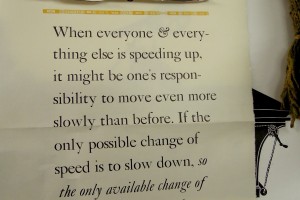Matrix 33 will contain some 160 pages, including 8 pages of colour plates; type specimens printed in France, Italy, America and the UK; and many other linocut, and line and colour illustrations. The contents will include:
‘A Hard Rain’s Gonna Fall’: Protest Images from the Nineteen Sixties by Dennis Gould; Herbert Jefferies, or The Bronze Buckaroo by Barbara Henry; Bradley Hutchinson – a Letterpress Fusion by Catherine Docter; Flaps & Hinges by Andrew Anderson; Hornby and the Daniels, their Correspondence by William S. Peterson; Reynolds Stone by Humphrey Stone; Lac Des Pleurs by Gaylord Schanilec; It’s Not Nostalgia, the Skill and Vision of Lowell Bodger by Paul Shaw; An Eighteenth-Century Factory for Bibles by Martyn Ould; The Rampant Lions Press at the Fitzwilliam Museum, 1982 by Sebastian Carter; Reprinting Printing Types: a Wander through the Design of Stephenson Blake’s Type Specimens by David Marshall and Elizabeth Ellis; Wood Type Revival by Tom Mayo; Tribulations of a Publishing Bookseller by George Ramsden; Matrix and Minnesota by John Randle; Donatus Pro Puerulis, the Lost Subiaco Edition and a Replica Imagined by Richard Årlin; Watermarks, and the Flow of Time by Enrico Tallone; From the Guild of St Joseph to Ditchling Museum by Jenny KilBride; Émigrés by Anna Nyburg; First Folio by Louisa Hare; La Fin du Monde by Celine Biewesch; Bristol to Mainz, with Bicycle and Adana by Nick Hand; A Bookseller’s Diary by Sophie Schneideman; Book Reviews by Paul W. Nash, John Randle and Patrick Randle.
Matrix 33 maintains the series’ eclectic approach to more or less anything to do with fine printing, letterpress in particular, post-1900. The reasoning behind this cut-off point was that Matrix should in itself form a source of information that future researchers would come to refer to, and when Matrix 1 made its appearance in 1981 it recorded memories that stretched back, at one remove, to the previous century. Occasionally we break the 1900 rule, as in 33 with Martyn Ould’s account of life at the OUP over a century earlier. In other respects Matrix, now having recorded around 1000 articles on the typographic renaissance of the 1900s, has become increasingly contemporary, recording the antics of the new generation that has discovered that ‘though locked tight in metal, it’s amazing how liberating letterpress can be’ (Matrix 26). This has indeed been a surprise, as we had always assumed that the traditions of letterpress would die out with our generation. Perhaps Matrix can even claim a little of the credit for keeping them alive and kicking. Hardly a day goes by when there is not some student activity at Whittington, and our open days on the first Saturday of each September now attract some hundreds of enthusiasts. It is heartening to see them all, with a leavening of retired letterpress comps and machine-men enjoying again the ‘alchemy of benzene, typewash, ink, paper, oil, offset spray, coal oil, steam radiators and a waft of dusty cedar’, as Vance Gerry described the fragrance of the Castle Press in Los Angeles in the 1940s in Matrix 6.
To reserve your copy please print, fill-in & return the below:
We have reserved for you
…….. regular copy/copies at £90 pre-publication
……… special copy/copies at £335 pre-publication, bound in quarter-leather with marbled sides, and which includes a portfolio of additional material, all in a slipcase.
Please could you send us a cheque for £……….. (inc p& p). If you prefer to pay by credit card, please contact [email protected].
Alternatively, we can now take Paypal payments at [email protected].
If you wish to pay in US$, please send a cheque for $165 for a regular copy, or $535 for a special, (including airfreight and conversion charges), made out to ‘John Randle’.
Matrix 33 is in proof, and will be posted in spring 2015. A limited number of Matrix 32 are available here.



